|
Books Should Be Free Loyal Books Free Public Domain Audiobooks & eBook Downloads |
|
|
Books Should Be Free Loyal Books Free Public Domain Audiobooks & eBook Downloads |
|
Fiction |
|---|
|
Book type:
Sort by:
View by:
|
By: Mrs. Humphry Ward (1851-1920) | |
|---|---|
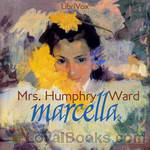 Marcella
Marcella
Mary Augusta Ward was a very popular author at the end of the 19th century. The arrival of Marcella was discussed a lot in the London news papers. This popular novel tells about Marcella Boyce, a beauty of the 1880s, who thinks she truly believes in the values of socialism. A 21-year-old art student, she lives in a boarding house in Kensington until her father inherits Mellor Park, the family estate which is located in the Midlands. She unwillingly leaving her studies, all the things she loves and wants to do, and her friends, and starts her new life at Mellor Park, determined to help the poor people she sees around her... | |
By: Mrs. L. T. Meade (1854-1914) | |
|---|---|
 The Rebel of the School
The Rebel of the School
Kathleen O’Hara is a young pretty girl sent to school in England from Ireland by her father to get a good education, but Kathleen has other ideas. She quickly become friends with the girls of the school who don’t pay for their education and in turn these girls consider Kathleen to be their Queen. What trouble will Kathleen and her friends get into? And what will the school do with the naughty, “Rebel of the School?” | |
By: Mrs. O. F. Walton (1849-1939) | |
|---|---|
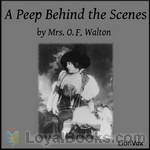 A Peep Behind the Scenes
A Peep Behind the Scenes
Rosalie is the daughter of a traveling theater master and is envied by many young girls as she appears to live a life full of glamour, glitz, and glory. But beneath the happy smiling face is a hurting heart, a deep sorrow for her dying mother, and a wretched life. Follow Rosalie as she learns of the Good Shepherd who loves and cares for her, and begins to trust Him for daily strength. | |
 Christie's Old Organ
Christie's Old Organ
Christie is all alone in the world after his mother dies. He lives in a boarding house and every night creeps up the attic stairs to hear an old barrel organ play. One night while he is listening, the organ stops and Christie hears a thump. What has happened? What should Christie do? | |
 Poppy's Presents
Poppy's Presents
One day, Poppy gets told her mother has a present for her. But the neighbors laugh and say there is such a thing as too much of a good thing. What is the present? | |
By: Murray Leinster (1896-1975) | |
|---|---|
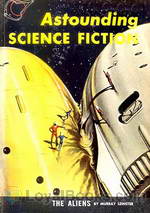 The Aliens
The Aliens
This story starts with space ships scouring the universe in an interplanetary game of tag. The humans know there are “Aliens” out there. But so do the Aliens. As each tries desperately to make the phenomenal discovery, they secretly hope that the other will not turn out to be the enemy. Humans call them “Plumies” because of the feathery plumes they inscribe on silicon-bronze tablets and cairns they have left behind on their intergalactic travels over the last thousand years. The search goes on, till one day somewhere in outer space, a Plumie ship collides with the one manned by humans... | |
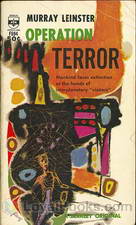 Operation Terror
Operation Terror
An unidentified space ship lands in a Colorado lake. Equipped with a paralyzing ray weapon, the creatures begin taking human prisoners. A loan land surveyor and a journalist are trapped inside the Army cordon, which is helpless against the mysterious enemy. Can they stop the aliens before it is too late? | |
 Space Tug
Space Tug
Joe Kenmore heard the airlock close with a sickening wheeze and then a clank. In desperation he turned toward Haney. “My God, we’ve been locked out!” Through the transparent domes of their space helmets, Joe could see a look of horror and disbelief pass across Haney’s face. But it was true! Joe and his crew were locked out of the Space Platform. Four thousand miles below circled the Earth. Under Joe’s feet rested the solid steel hull of his home in outer space. But without tools there was no hope of getting back inside. Joe looked at his oxygen meter. It registered thirty minutes to live. | |
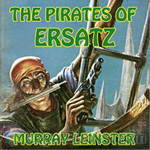 The Pirates of Ersatz
The Pirates of Ersatz
Bron is the offspring of infamous space pirates but instead of following in the family footsteps he decides to become an electronic engineer. Unfortunately, every time he tries to get out, something pulls him back in. This is a tongue-in-cheek space adventure along the lines of the Stainless Steel Rat by Harry Harrison. It was originally published in the FEB-APR issues of Astounding Science Fiction in 1959. | |
 The Mad Planet
The Mad Planet
It is 30,000 years following dramatically changed climate conditions on earth which had let massive amounts of carbon dioxide belch from the interior of the planet into the atmosphere. Over the millenia this would have quite devastating effects on life as it had once been known. Much of the human and animal population would not survive the climate change, and indeed those few humans who did survive knew nothing of all which their predecessors had learned and built. Indeed, they knew not even of their existence... | |
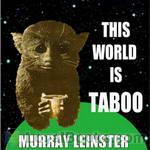 This World Is Taboo
This World Is Taboo
Calhoun is an Interstellar Medical Serviceman, and he's needed on Dara. Trouble is: Dara is forbidden. Taboo. And breaking quarantine will make Calhoun a presumed plague-carrier and subject to being shot on sight by anyone from Weald. But hey! If he did the smart thing, we wouldn't have a story!But why are men from Dara shooting at him? | |
 Talents, Incorporated
Talents, Incorporated
Bors felt as if he'd been hit over the head. This was ridiculous! He'd planned and carried out the destruction of that warship because the information of its existence and location was verified by a magnetometer.But, if he'd known how the information had been obtained--if he'd known it had been guessed at by a discharged spaceport employee, and a paranoid personality, and a man who used a hazel twig or something similar--if he'd known that, he'd never have dreamed of accepting it. He'd have dismissed it flatly! | |
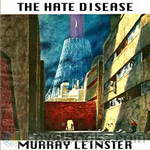 The Hate Disease
The Hate Disease
Dr. Calhoun and his pet tormal Murgatroyd work for the Interstellar Medical Service making routine public health inspections on far-flung colonial planets. When they reach Tallien Three they are greeted with a rocket attack by the Paras, a mutated form of human rapidly replacing the “normals”. The normals think it’s a pandemic of demonic possession but Calhoun has his doubts. If he can keep from turning into a Para, or being assassinated by them he just might figure this thing out. – The Hate Disease was first published in the August 1963 edition of Analog Science Fact and Fiction magazine. | |
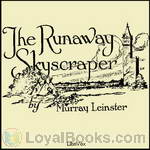 The Runaway Skyscraper
The Runaway Skyscraper
Arthur Chamberlain has problems. His one-man engineering firm is faltering and his pretty secretary Estelle barely notices him. But these problems are put aside when his Manhattan office building falls into the fourth dimension. Madison Square is filled with wigwams and it’s up to Arthur to engineer a way to make his building to fall back to the future. – The Runaway Skyscraper first appeared in the February 22, 1919 issue of Argosy magazine. | |
 Operation: Outer Space
Operation: Outer Space
Jed Cochrane is about to take off on man's first interstellar voyage. His mission: Make sure it's good television! (Introduction by Mark Nelson) | |
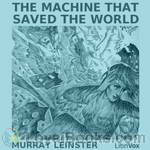 The Machine that Saved the World
The Machine that Saved the World
They were broadcasts from nowhere--sinister emanations flooding in from space--smashing any receiver that picked them up. What defense could Earth devise against science such as this? In the far future of 1972, on a secret military installation, Staff Sergeant Bellews is an expert on the latest scientific discovery: a way for ordinary machines like vacuums and lawnmowers to gather experience in their jobs, becoming error free over time. Then the strange broadcasts began to blow up transmitters everywhere. Were they from space? Enemies? the future? He didn't care until they started messin' with his machines. Then he took it personally. (summary from the first chapter and Phil Chenevert) | |
 The Ambulance Made Two Trips
The Ambulance Made Two Trips
Big Jake Connors is taking over his town through violence, inimidation and bribery but Detective Sergeant Fitzgerald can only grind his teeth in frustration. The gangsters seem to have everything going their way until the day that a little dry cleaning establishment declines their offer of 'protection' and strange things start to happen. Murray Leinster gives us another wonderful product of 'what if' from his limitless imagination to enjoy in this gem of a story. Listen and smile. | |
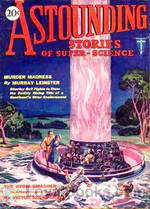 Murder Madness
Murder Madness
Murder Madness! Seven Secret Service men had completely disappeared. Another had been found a screaming, homicidal maniac, whose fingers writhed like snakes. So Bell, of the secret "Trade," plunges into South America after The Master--the mighty, unknown octopus of power whose diabolical poison threatens a continent! | |
 Tanks
Tanks
Tanks and the future of war is what Murray Leinster speculates about in this story. Written in the 1920's he observed the terrible new inventions that were used in World War I to kill people, armored tanks and poisoned gas and then tells us how war will be fought in the future. In this case the war will occur in 1932 and be between the US and the 'Yellow enemy'. It was published in the very first issue of Astounding Stories of Super Science, January 1930. It is science fiction in the sense that it guesses what the future will hold for man based on developing the technology that was coming into being at the time, the 1920's... | |
 Forgotten Planet
Forgotten Planet
The "forgotten" planet had been seeded for life, first with microbes and later with plants and insects. A third expedition, intended to complete the seeding with animals, never occurred. Over the millennia the insects and plants grew to gigantic sizes. The action of the novel describes the fight for survival by descendants of a crashed spaceship as they battle wolf-sized ants, flies the size of chickens, and gigantic flying wasps. | |
 Creatures of the Abyss
Creatures of the Abyss
Orejas de ellos, "the things that listen", whispered the superstitious fishermen when the strange occurrences began off the Philippine coast. How else explain the sudden disappearance of a vessel beneath a mysterious curtain of foam? The writhings of thousands of maddened fish trapped in a coffin-like area of ocean? What monsters gorged at the bottom of the Luzon Deep and what were their plans? Radar expert Terry Holt and the crew of the Esperance had to devise a weapon against the horrifying creatures which threatened mankind with extinction. Here are terror, excitement, and the clutch of cold death as combined by a master hand in the field of science fiction. | |
 Wailing Asteroid
Wailing Asteroid
There was no life on the asteroid, but the miles of rock-hewn corridors through which the earth party wandered left no doubt about the purpose of the asteroid. It was a mighty fortress, stocked with weapons of destruction beyond man's power to understand. And yet there was no life here, nor had there been for untold centuries. What race had built this stronghold? What unimaginable power were they defending against? Why was it abandoned? There was no answer, all was dead. But—not quite all. For in a room above the tomb-like fortress a powerful transmitter beamed its birdlike, fluting sounds toward earth... | |
 Juju
Juju
A 1919 pulp-press tale of deepest darkest Africa. | |
 Red Dust
Red Dust
You who have read "The Mad Planet" by Murray Leinster, will welcome the sequel to that story. The world, in a far distant future, is peopled with huge insects and titanic fungus growths. Life has been greatly altered, and tiny Man is now in the process of becoming acclimated to the change. We again meet our hero Burl, but this time a far greater danger menaces the human race. The huge insects are still in evidence, but the terror they inspire is as nothing compared to the deadly Red Dust. You will follow this remarkable story with breathless interest... | |
 Planet of Dread
Planet of Dread
Humans have expanded to myriads of worlds throughout the galaxies but they have found that the only way for colonies to be self sustaining, was to reproduce the total ecology of their home world; the original Earth. This meant bringing the entire ecosystem, the good, the bad and the ugly. Viruses as well as grass, goats as well as stink bugs and allowing the whole mixture to ultimately produce an inhabitable world for humans. But what happens when this system is not properly supervised? Moran and the others in the space yacht Nadine find a world where strange things have been brewing for over a hundred years and may or may not survive an environment gone mad. | |
 Nightmare Planet
Nightmare Planet
In science-fiction, as in all categories of fiction, there are stories that are so outstanding from the standpoint of characterization, concept, and background development that they remain popular for decades. Two such stories were Murray Leinster's The Mad Planet and Red Dust. Originally published in 1923, they have been reprinted frequently both here and abroad. They are now scheduled for book publication. Especially for this magazine, Murray Leinster has written the final story in the series. It is not necessary to have read the previous stories to enjoy this one... | |
 Med Ship Man
Med Ship Man
Join Space Medical Service officer Calhoun and his sidekick Murgatroyd the tormal on another exciting adventure, this time on what should be a routine visit to the planet Maya, which upon arrival appears to be completely devoid of all life! | |
By: Myrtle Reed (1874-1911) | |
|---|---|
 Lavender and Old Lace
Lavender and Old Lace
“Jane Hathaway and her niece, Ruth Thorne, have never met. Jane invites Ruth for a visit, but leaves before Ruth comes. Ruth agrees to come to Jane for quiet and rest. When Ruth arrives, the maid gives her a letter from her aunt. In the letter, Aunt Jane does not tell Ruth anything about her trip abroad but insists that Ruth light an oil lamp in the attic each night. Very soon, the all together forgotten past and the steady present are united.” | |
 A Spinner in the Sun
A Spinner in the Sun
Myrtle Reed may always be depended upon to write a story in which poetry, charm, tenderness and humor are combined into a clever and entertaining book. Her characters are delightful and she always displays a quaint humor of expression and a quiet feeling of pathos which give a touch of active realism to all her writings.In "A Spinner in the Sun" she tells an old-fashioned love story, of a veiled lady who lives in solitude and whose features her neighbors have never seen. There is a mystery at the heart of the book that throws over it the glamour of romance | |
 At The Sign of The Jack O'Lantern
At The Sign of The Jack O'Lantern
This begins with an odd inheritance at the end of a honeymoon, both parties being inexperienced. Then someone comes to visit, then another, until we've got a chaotic bedlam of New England's tragically off the wall odd-ball relations. Our protagonists may not communicate efficiently at first but at least they've got a sense of humours. The humourous style keeps up as well as some moments of lustre and rich feeling about the printed word itself. (Introduction by D. Wor) | |
 Old Rose and Silver
Old Rose and Silver
The novel follows the lives of Rose and her widowed Aunt, Madame Francesca Bernard, along with young visitor and cousin Isabel, whose lives are changed by the return of an old friend and neighbour Colonel Kent, and his grown son, Allison. Other characters that help shape their lives in significant ways are the Crosby twins, unconventional and uninhibited youths that set society at naught, and an unconventional doctor who specializes in the impossible. Through the limited "wide-scope" descriptions... | |
 A Spinner in the Sun (dramatic reading)
A Spinner in the Sun (dramatic reading)
Myrtle Reed may always be depended upon to write a story in which poetry, charm, tenderness and humor are combined into a clever and entertaining book. Her characters are delightful and she always displays a quaint humor of expression and a quiet feeling of pathos which give a touch of active realism to all her writings. In "A Spinner in the Sun" she tells an old-fashioned love story, of a veiled lady who lives in solitude and whose features her neighbors have never seen. There is a mystery at the heart of the book that throws over it the glamour of romance. | |
By: Natalie Sumner Lincoln (1881-1935) | |
|---|---|
 The Red Seal
The Red Seal
Nothing is what it seems to be as events unfold in this entertaining mystery by Natalie Sumner Lincoln. Red seals and red herrings abound and will keep you guessing all the way through the final chapter! | |
 Cat's Paw
Cat's Paw
Susan Baird is found dead at her tea-table and all the evidence points to murder. She is supposed to have been penniless but when her will is found her niece Kitty inherits a fortune. Grave suspicion shifts from one person to another and the two suitors for Kitty's hand whom Washington society had watched with interest seem closely connected with the many clues which again and again prove worthless. Until the closing chapters unravel the mystery you suspect the most innocent people and the real murderer and his fiendish devices come as a shock. - Summary from "The Book Review Digest" 1923 | |
 Unseen Ear
Unseen Ear
Judith Richards is seated alone in her father's library at midnight, when a man enters, rifles her father's safe, and is examining his loot when a steel blade darts thru the portières, pierces him and he falls dead to the floor. Judith meanwhile has remained undisturbed, for she is seated with her back to the intruder and she is, moreover, stone deaf. When she finally rises to leave the room, she discovers the crime, and recognizes the victim as the stepson of her uncle. Detective Ferguson comes to the conclusion that the murder must have been an inside job, and the members of the household come under suspicion... | |
By: Nathan Gallizier (1866-1927) | |
|---|---|
 Under the Witches' Moon
Under the Witches' Moon
The scene is Rome, 935 A.D. Thirty-year-old Tristan, dressed as a pilgrim, overhears a conversation between Basil, the Grand Chamberlain, and Il Gobbo, his assistant. After the two have left, Tristan continues to observe the revelry on the Eve of St. John. Suddenly a chariot containing a beautiful woman stops before him. They exchange words. He kisses her hand. Then she moves on, leaving him to ponder her beauty as he returns to the inn where he is staying. That night he has an enchanting and haunting dream of him together with another woman... | |
By: Nathaniel Hawthorne (1804-1864) | |
|---|---|
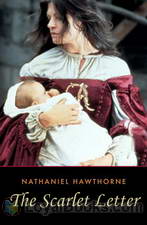 The Scarlet Letter
The Scarlet Letter
A beautiful woman who is punished for the mortal sin of loving a man other than her husband, a cowardly lover, a vengeful husband, a rebellious illegitimate child and the oppressive and patriarchal morality of 17th century Puritanism in Boston. Together these form an unforgettable and thought-provoking glimpse of how much social attitudes have changed over the centuries. Nathaniel Hawthorne was the creator of such beloved works as Twice-Told Tales, A Wonder Book for Boys and Girls, The House of the Seven Gables and spine-chilling tales like Roger Malvin's Burial... | |
 Tanglewood Tales
Tanglewood Tales
A sequel to Nathaniel Hawthorne's earlier volume of Greek mythology interpreted and retold for young people, Tanglewood Tales includes more legends and tales of ancient heroes and monsters. In his earlier book, A Wonder-Book for Girls and Boys, Hawthorne had designed the book to be a book within a book. A young college student keeps a group of young children entertained by retelling Greek myths in a way in which they can easily understand. Nathaniel Hawthorne also wrote a brief introduction to Tanglewood Tales, entitled The Wayside... | |
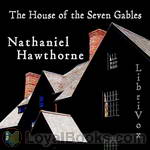 The House of the Seven Gables
The House of the Seven Gables
“The wrongdoing of one generation lives into the successive ones and… becomes a pure and uncontrollable mischief.” Hawthorne’s moral for “The House of the Seven Gables,” taken from the Preface, accurately presages his story. The full weight of the gloomy mansion of the title seems to sit on the fortunes of the Pyncheon family. An ancestor took advantage of the Salem witch trials to wrest away the land whereon the house would be raised… but the land’s owner, about to be executed as a wizard, cursed the Pyncheon family until such time as they should make restitution... | |
 Rappaccini's Daughter
Rappaccini's Daughter
The story is set in Padua in a distant, but unspecified past. From his quarters, Giovanni, a young student of letters, observes Beatrice, the beautiful daughter of Dr. Rappaccini, a scientist working in isolation. Beatrice is confined to the lush and locked gardens filled with poisonous plants by her father. Having fallen in love, Giovanni enters the garden and meets with Beatrice a number of times regardless of the warning of his mentor, Professor Baglioni, that Rappaccini is up to no good and he and his work should be avoided. | |
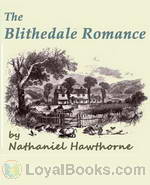 The Blithedale Romance
The Blithedale Romance
The Blithedale Romance is the story of four principal characters who work with -- and sometimes against -- each other on Blithedale, a communal farm antecedent to those that sprang up later in the 1960s, and similar to one on which Hawthorne himself lived in 1841. These communes arose out of the pressures on society and the individual brought by the Industrial Revolution. Some were organized around religious philosophies, some were secular. Among the secularists, the Transcendental movement mentioned in the novel espoused the idea that the individual's intuition, rather than religious dogma, was the true path to spiritual enlightenment... | |
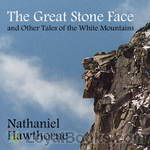 The Great Stone Face and Other Tales of the White Mountains
The Great Stone Face and Other Tales of the White Mountains
A collection of four short stories by Nathaniel Hawthorne, the common theme of which is New Hampshire's White Mountains. Consists of: The Great Stone Face, written in 1850 and revolves around the 'Old Man of the Mountain (Cannon Mtn.) in New Hampshire which sadly collapsed on May 3, 2003; The Ambitious Guest, written in 1835; The Great Carbuncle, written in 1837; and Sketches From Memory, written sometime prior to The Great Carbuncle as will become obvious. | |
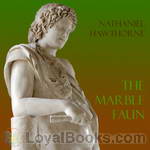 The Marble Faun
The Marble Faun
The Marble Faun is Hawthorne's most unusual romance. Writing on the eve of the American Civil War, Hawthorne set his story in a fantastical Italy. The romance mixes elements of a fable, pastoral, gothic novel, and travel guide. In the spring of 1858, Hawthorne was inspired to write his romance when he saw the Faun of Praxiteles in a Roman sculpture gallery. The theme, characteristic of Hawthorne, is guilt and the Fall of Man. The four main characters are Miriam, a beautiful painter who is compared... | |
 Twice Told Tales
Twice Told Tales
Twice-Told Tales is a short story collection in two volumes by Nathaniel Hawthorne. The first was published in the spring of 1837, and the second in 1842. The stories had all been previously published in magazines and annuals, hence the name. (Introduction by Wikipedia) | |
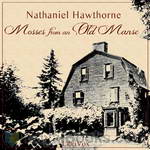 Mosses from an Old Manse
Mosses from an Old Manse
"Mosses from an Old Manse" is a short story collection by Nathaniel Hawthorne, first published in 1846. The collection includes several previously-published short stories and is named in honor of The Old Manse where Hawthorne and his wife lived for the first three years of their marriage. A second edition was published in 1854, which added "Feathertop," "Passages from a Relinquished Work, and "Sketches from Memory."Many of the tales collected in "Mosses from an Old Manse" are allegories and, typical of Hawthorne, focus on the negative side of human nature... | |
 Dolliver Romance and Other Pieces
Dolliver Romance and Other Pieces
This post-humous collection of stories, sketches and essays by celebrated quintessential New England author Nathaniel Hawthorne gives us glimpses of the many different facets of Hawthorne's personality. The titular tale The Dolliver Romance was an unfinished manuscript that was edited and prepared for publication after Hawthorne's death and relates the story of an aged man with a small child in his care who swallows a magical tincture daily that rejuvenates his vitality, reversing the aging process... | |
By: Neil Boyton, S.J. (1884-1956) | |
|---|---|
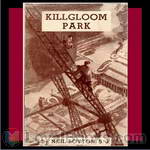 Killgloom Park
Killgloom Park
Join Angelo Daily and his chums during a fun filled summer at Killgloom Park, a Coney Island, New York amusement park in the 1930's. A runaway tiger! Tracking down a wanted thief! Climbing down a ferris wheel in the middle of the night! These are just a few of the exciting things that happen during this adventurous summer!The author grew up in the world of amusement parks, providing first hand material for two of his boys books – “On the Sands of Coney” and its sequel, this title - “Killgloom Park”... | |
By: Neil Munro (1863-1930) | |
|---|---|
 Doom Castle
Doom Castle
Doom Castle is the story of young Count Victor's journey to Scotland after the Jacobite Rebellion, searching for a traitor to the Jacobite cause as well as a mysterious man under the name of "Drimdarroch", whom he swore revenge. After a perilious journey, Count Victor arrives at Doom Castle as a guest of the enigmatic Baron of Doom, his two strange servitors and his beautiful daughter... (Summary by Carolin) | |
By: Nella Larsen (1891-1964) | |
|---|---|
 Passing
Passing
Nella Larsen, a writer of the Harlem Renaissance, wrote two brilliant novels that interrogated issues of gender and race. In Passing, her second novel published in 1929, she examines the troubled friendship between two mixed-race women who can pass as white. One, Irene Redfield, marries a black man and lives in Harlem, while the other, Clare Kendry, marries a bigoted white man. Clare re-enters Irene's life after an absence of many years, and stirs up painful questions about identity. (Introduction by Elizabeth Klett) | |
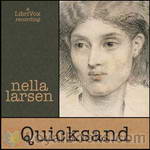 Quicksand
Quicksand
Quicksand is a 1928 novel by Nella Larsen, a writer of the Harlem Renaissance. It focuses on Helga Crane, a mixed-race woman who is a schoolteacher in the American south. As the novel opens, she suddenly decides to give up her teaching position and go north, back to her roots in Chicago. Helga's restless search for identity is semi-autobiographical, inspired by Larsen's own struggles to reconcile her mixed heritage with the racism of 1920s America. Although this novel was published after 1923, the copyright was never renewed and is therefore in the public domain. (Introduction by Elizabeth Klett) | |
By: Nicholas Carter | |
|---|---|
 Snarled Identities
Snarled Identities
Nick Carter is a fictional detective who first appeared in 1886 in dime store novels. Over the years, different authors, all taking the nom de plume Nicholas Carter, have penned stories featuring "America's greatest detective". It is time for Nick to take a much-earned vacation, but Chick is disconcerted to see him continuing to read the newspaper. Who know what mystery will catch his eye? Suddenly, he notices the announcement of the death of his old adversary 'Green-Eye Gordon'. | |
 Man Without a Conscience
Man Without a Conscience
Nick Carter is a fictional detective who first appeared in 1886 in dime store novels. Over the years, different authors, all taking the nom de plume Nicholas Carter, have penned stories featuring "America's greatest detective". In this story, Nick has been contacted by his old friend, Chief Weston, of the Boston Police Department. When he arrives, he is shown a photograph, depicting a crime in progress and is informed there has been a spate of holdups on local highways. Something has to be done but Nick doesn't usually resort to consulting a fortune teller! | |
 Stolen Name
Stolen Name
Nick Carter is a fictional detective who first appeared in 1886 in dime store novels. Over the years, different authors, all taking the nom de plume Nicholas Carter, have penned stories featuring "America's greatest detective". In this story, Nick finds himself in a quandary. He must choose between helping a friend, with a dubious past or arresting a master crook, long thought dead, but now setting up a new scam. Will he save his friend or, with the help of his assistants, stop the thief in his tracks? | |
 Twin Mystery
Twin Mystery
Nick Carter is a fictional detective who first appeared in 1886 in dime store novels. Over the years, different authors, all taking the nom de plume Nicholas Carter, have penned stories featuring "America's greatest detective". In this story, Nick receives a letter foretelling of a murder. His wife, Edith, believes it was from a woman... but who is the Brown Robin, and why taunt the great detective? - Summary by Lynne Thompson | |
 Fatal Message
Fatal Message
Nick Carter is a fictional detective who first appeared in 1886 in dime store novels. Over the years, different authors, all taking the nom de plume Nicholas Carter, have penned stories featuring "America's greatest detective". This tale opens with Nick eavesdropping on two strangers in the next booth as he finishes his lunch. One of the men works at the telegraph office and is discussing an unusual wire he received. Nick's interest is aroused. | |
 Under the Tiger's Claws; or, A Struggle for the Right (Version 2)
Under the Tiger's Claws; or, A Struggle for the Right (Version 2)
A prominent banker calls Nick Carter in to investigate $90,000 in missing funds—and a trusted clerk who has disappeared. [Summary by Paul Hampton] | |
 Under the Tiger's Claws
Under the Tiger's Claws
Nick Carter is a fictional detective who first appeared in 1886 in dime store novels. Over the years, different authors, all taking the nom de plume Nicholas Carter, have penned stories featuring "America's greatest detective". In this story, Nick is called to visit his banker friend, Mr. Gilsley, who is concerned about some missing money. Also present at the meeting is Belle Braddon, the banker's stenographer. Although the young woman is striking, there is something about her that Nick doesn't trust. - Summary by Lynne Thomson | |
 Sharper's Downfall; Or, Into the Net
Sharper's Downfall; Or, Into the Net
Bigamy, blackmail, damsels in distress, gambling and kidnapping--this story has it all, plus Nick Carter and his crew in hot pursuit of the criminals. - Summary by Paul Hampton | |
 Mask of Death
Mask of Death
America's greatest detective is back! "Nick Carter will solve the mystery. No crime is too deep for him. He’ll ferret out the truth and run down the rascals. He will recover your lost treasures, too, Mr. Strickland, one and all of them, take my word for it. If there is one man on earth who can accomplish it, Nick Carter is that one man. So pull yourself together, sir, and face this calamity man fashion." Mr. Rudolph Strickland's apartment occupies the entire floor of the building and was crammed with priceless treasure. The robbery threatens to destroy his fragile health.[/ | |
 Out of Death's Shadow
Out of Death's Shadow
Nick Carter is a fictional private detective who first appeared in 1886 in dime store novels. Over the years, different authors, all taking the nom de plume Nicholas Carter, have penned stories. Here, the tale begins with the trial of a woman, sure to be convicted and face the gallows. Or is she? | |